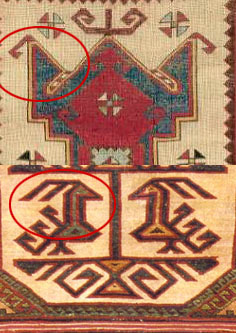
|
"The Chateau de Gourdon" Lori Pambak rug Kazak rug - inspired by this famous 19th century Lori Pambak rug (click here to view the antique Chateau de Gourdon Lori Pambak rug Kazak rug) Code: BRLP0607 Size: 143x177cm (184cm including fringes) Size (ft): 4'8"x5'9" (6' including fringes) Area: 2.63 m2 Density: 110 000 knots per square meter, totally ~280 000 knots Colors: red, navy blue, midnight blue, medium blue (selvedge), yellow, green, purple, aubergine, dark brown, ivory. Dyes: madder, weld (Reseda Luteola), onion skins, indigo, pomegranate skins, walnut husks, natural dark brown sheep wool, natural ivory sheep wool. Materials: Handcarded and handspun wool for pile, ivory wool warps and light red wool wefts (dyed with onion skins and madder, two shots). 1cm of flatwoven kilim ends at both sides. - wool on wool Knots: Gördes (Turkish, symmetrical) Pile height: 0.6cm Ends: Horizontal band of oblique interlacing warps. Braided fringes, tied with colorful threads Inscriptions:  "Umay" - a female spirit that that protects babies in Turkic mythology. Umay is also a bringer of luck, abundance, and fertility. The inscription is located in the right top side of the main border.  tamga (tribal seal) of Afshar tribe (left top corner) Weaver: Könül Weaving Period: Three months Handwoven in Azerbaijan Design: The shaded madder red field with this large central medallion flanked by various polychrome tribal ornaments on each side, in an ivory main border of stylized motif between indigo blue polychrome dragon "S" and flower-head motifs minor borders and outer barber pole stripes. The distinctive quatrefoil medallion is believed by some authors to be derived from an early Central Asian totemic symbol representing pairs of animals / birds, which can also be found in early Turkish rugs. The below picture shows a comparison of a part of the Lori Pambak medallion containing (4) opposed pairs of animals/birds and reciptocal bird motif used in the early Turkish rugs.  The early fifteenth century Turkish rug with conventionalised animal-forms, National Historical Museum, Stockholm. For a full sized image of this rug, see here |
Contact us for more information about this rug

.jpg)
.jpg)
.jpg)
.jpg)
.jpg)
.jpg)
.jpg)
.jpg)
.jpg)
.jpg)
Contact us for more information about this rug

|
For more information about the above rug or to place an order please email
vd@azerbaijanrugs.com |